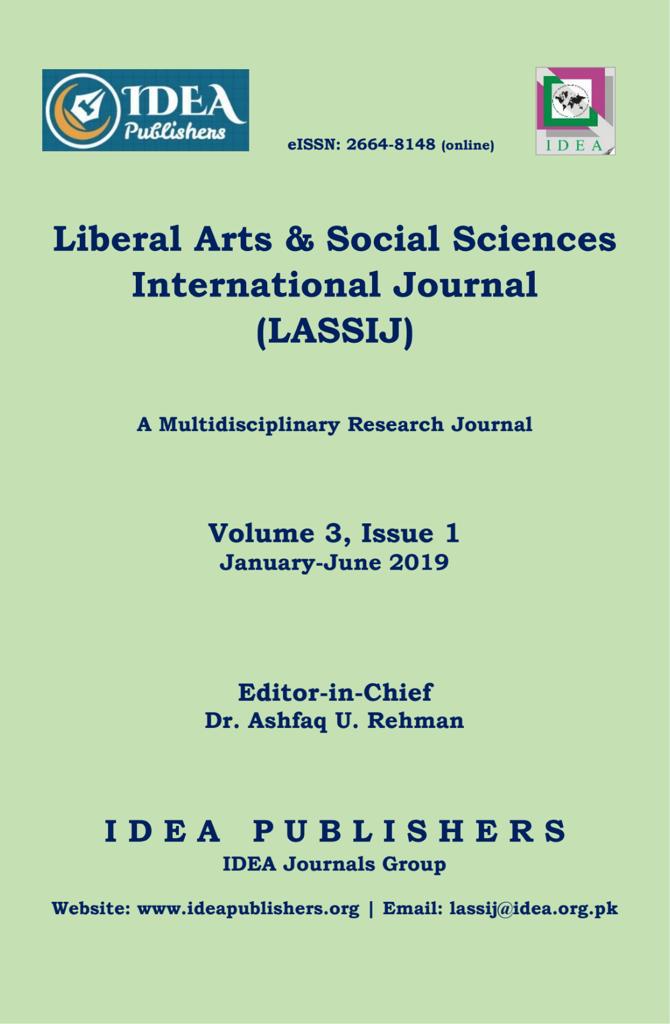The Effects of Militancy and Military Operations on Pashtun Culture and Traditions in FATA
DOI:
https://doi.org/10.47264/idea.lassij/3.1.7Keywords:
War on Terror, FATA, Militancy, Military Operations, Cultural ImpactsAbstract
Two events in the last five decades proved to be disastrous for the Federally Administered Tribal Areas (FATA), now part of KP province: the USSR invasion of Afghanistan in 1979 and ‘War on Terror' initiated by the US against militants in Afghanistan in 2001. After the incident of 9/11, FATA became the centre of global terrorism and emerged as the most dangerous place. Taliban’s rule was overthrown in Kabul, and they escaped and found refugees across the eastern border of Afghanistan with Pakistan. This paper aims at studying the emergence of Talibanization in FATA and its impacts on the local culture and religion. Furthermore, the research studies the effects of military operations on FATA’s cultural values and codes of life. Taliban, in FATA, while taking advantage of the local vulnerabilities and the state policy of appeasement, started expanding their roots and networks throughout the country. They conducted attacks on the civilians and security forces particularly when Pakistan joined the US ‘war on terror.’ Both the militancy and the military operations have left deep imprints thus affected the local culture, customs, values, and religious orientations in FATA.
References
Afsar, S. A., & Samples, C. A. (2008). “The evolution of the Taliban.” Doctoral Dissertation, Monterey California: Naval Postgraduate School.
Ahmad, E. (2002). Terrorism: Theirs and ours. New York: Seven Stories Press.
Azim, S. W., Mehmood, W., & Hussain, S. (2018). Swat conflict in retrospect: Violence and Jarga among the Swat Pashtuns in Pakistan. Liberal Arts and Social Sciences International Journal (LASSIJ), 2(1), 37-48. https://doi.org/10.47264/idea.lassij/2.1.5
Baloch, Z. (2016). Pakistan’s Post 9/11 Afghan policy: Impact on FATA. Central Asia Journal, 78(1), 38-54. Retrieved from, https://docs.google.com/viewer?url=journals.uop.edu.pk/view_paper.php?paper_id=497&embedded=true
Basit, A. (2010). Life in FATA amid ongoing conflict. In Dynamics of Taliban insurgency in FATA. Pak Institute for Peace Studies.
Bibi, N. (2019, January 15). Telephonic interview with Nargis Bibi by first author. She is an elderly local female of FATA.
Burki, K. Z. (2010). Rise of Taliban in Waziristan. Dialogue, 5(3), 188-211. https://www.qurtuba.edu.pk/thedialogue/The%20Dialogue/5_3/Dialogue_July_September2010_188-211.pdf
Chughtai, M. W. (2013). The Impact of Rising Terrorism and Military Operations on Socio-Economic Culture of Federally Administered Tribal Areas (FATA) of Pakistan. TIGAH: A Journal of Peace and Development, 3(1), 18-32. https://frc.org.pk/publications/tigah-a-journal-of-peace-and-development-volume-iii-july-2013-2/
Ghumman, Z. (2006, April 18). Taliban killed 150 pro-government Maliks. Daily Times.
Gunaratna, R., & Nielsen, A. (2008). Al Qaeda in the Tribal Areas of Pakistan and beyond. Studies in Conflict & Terrorism, 31(9), 775-807. https://doi.org/10.1080/10576100802291568
Hilali, A. Z. (2017). US-Pakistan relationship: Soviet invasion of Afghanistan. Taylor & Francis.
Huntington, S., P. (1996). The Clash of Civilization and the Remaking of World Order. New York: Simon & Schuster.
International Crisis Group. (2006). Pakistan’s Tribal Areas: appeasing the militants. Crisis Group Asia Report, (125). https://www.crisisgroup.org/asia/south-asia/pakistan/pakistan-s-tribal-areas-appeasing-militants
Kakar, A. K. (2017, August 20). Origin and Growth pattern of Islamic organizations in Pakistan. Retrieved from The Balochistan Point, http://thebalochistanpoint.com/origins-and-growth-pattern-of-islamic-organizations-in-pakistan/
Kakar, Y (2014, July 11). Pashtunwali and Foreign militants in FATA. Retrieved from The Baluchistan Point, http://thebalochistanpoint.com/pashtunwali-and-foreign-militants-in-fata/
Khan, Z. A. (2012). Military operations in FATA and PATA: Implications for Pakistan. Strategic Studies, 31(4), 120-129. http://issi.org.pk/wp-content/uploads/2014/06/1339999992_58398784.pdf
Knudsen, A. (2002). Political Islam in South Asia. Chr. Michelsen Institute.
Mahmood, A. Ullah, S. & Ashfaq, S. (2018). The evolution of Jirga system: A conflict resolution mechanism in FATA. Liberal Arts and Social Sciences International Journal (LASSIJ), 2(1), 21-28. https://doi.org/10.47264/idea.lassij/2.1.3
Mahsud, R. (2016, May 24). The lost culture of South Waziristan Agency, Fata. Retrieved from Daily Times, https://dailytimes.com.pk/80408/the-lost-culture-of-south-waziristan-agency-fata/
Mehsud, W. (2019, January 18). Personal interview by principal author with Wahid Mehsud from FATA.
Naazer, M. A., Mahmood, A. & Ashfaq, S. (2017). Political rights situation during Musharraf era: 1999-2004. Liberal Arts and Social Sciences International Journal (LASSIJ), 1(1), 20-31. https://doi.org/10.47264/idea.lassij/1.1.3
Rana, M. A. (2009). Taliban insurgency in Pakistan: A counterinsurgency perspective. Conflict and Peace Studies, 2(2), 9-31. https://www.pakpips.com/web/wp-content/uploads/2017/11/169.pdf
Rana, M. A., Sial, S., & Basit, A. (2010). Dynamics of Taliban insurgency in FATA. Pak Institute for Peace Studies.
Rashid, A. (2012). Descent into chaos: How the war against Islamic extremism is being lost in Pakistan, Afghanistan, and Central Asia. Penguin UK.
Rehman, A. U., Rahman, B., & Ali, T. (2018). US war on terror: Portrayal through caricatures in selected newspapers of Pakistan. Pakistan Journal of Criminology, 10(3), 41-63. http://www.pjcriminology.com/publications/us-war-on-terror-portrayal-through-caricatures-in-selected-newspapers-of-pakistan/
Roy, O. (1999). Changing patterns among radical Islamic movements. Brown Journal of World Affairs, 6, 98-109. https://bjwa.brown.edu/6-1/changing-patterns-among-radical-islamic-movements/
Salim, A., Semetko, H. A., & Zehraa, S. (2018). Pak-US strategic partnership and challenge of internal radical symbiosis. Liberal Arts and Social Sciences International Journal (LASSIJ), 2(1), 57-64. https://doi.org/10.47264/idea.lassij/2.1.7
Shafiq, S. & Rehman, A. U. (2018). Land, conflict and traditional institutions in the North-West Pakistan: An appraisal of Hazarkhwani Peshawar. Journal of the Punjab University Historical Society, 31(1), 235-246. http://pu.edu.pk/images/journal/HistoryPStudies/PDF_Files/22_V-31-No1-Jan18.pdf
Shams-ur-Rehman, G. (2015). Pashtunwali and Islam: The conflict of authority in the traditional Pashtun society. Pakistan Journal of Social Sciences, 35, 297-307. http://www.bzu.edu.pk/PJSS/Vol35No12015/PJSS-Vol35-No1-24.pdf
Ullah, I. (2016, March 9). Remembering a Waziristan where men and women once danced together. Retrieved from Daily Dawn, https://www.dawn.com/news/1244535
Wazir, S. (2019, January 3). Personal interview of the principal author with Safdar Wazir from FATA.
White, J. T. (2008). Pakistan's Islamist Frontier: Islamic Politics and US Policy in Pakistan's North-West Frontier. Centre on Faith & International Affairs.
Zaman K. (2019, January 7). The first author interviewed Khan Zaman. He is a PhD Candidate at the Department of History, Quaid-e-Azam University (QAU), Islamabad.
Downloads
Published
How to Cite
Issue
Section
License
Copyright (c) 2019 Surat Khan, Tayyab Wazir, Arif Khan

This work is licensed under a Creative Commons Attribution-NonCommercial 4.0 International License.
Please click here for details about the LASSIJ's Licensing and Copyright policies.















